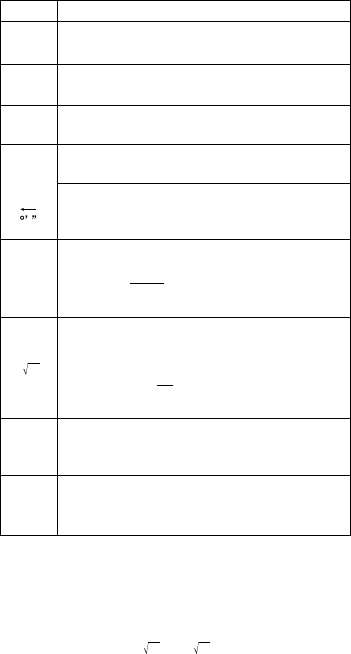
E-33
Functions Input Range
nCr
0Ϲ n 1҂10
10
, 0Ϲ r Ϲ n (n, r are integers)
1Ϲ [n!/{r!(n–r)!}] 1҂10
100
Pol(x, y)
ȊxȊ, ȊyȊ Ϲ9.999999999҂10
49
(x
2
+y
2
) Ϲ9.999999999҂10
99
Rec(r,
)
0Ϲ r Ϲ9.999999999҂10
99
θ: Same as sinx
ȊaȊ, b, c 1҂10
100
°’ ”
0 Ϲ b, c
ȊxȊ1҂10
100
Decimal ↔ Sexagesimal Conversions
0°0°0°Ϲ ȊxȊ Ϲ999999°59°
x0: –1҂10
100
ylogx100
^(x
y
)
x҃0: y0
x0: y҃n, (n is an integer)
However: –1҂10
100
ylogȊxȊ100
y0: x G 0
–1҂10
100
1/x logy100
x
y
y҃0: x0
y0: x҃2nѿ1, (n G 0; n is an integer)
However: –1҂10
100
1/x logȊyȊ100
a
b
/c
SD
Ȋ
xȊ 1҂10
50
ȊyȊ 1҂10
50
(REG)
Ȋ
nȊ 1҂10
100
* For a single calculation, calculation error is ±1 at the
10th digit. (In the case of exponential display, calcula-
tion error is ±1 at the last significant digit.) Errors are
cumulative in the case of consecutive calculations, which
can also cause them to become large. (This is also true
of internal consecutive calculations that are performed
in the case of ^(
x
y
),
x
y , x!,
3
, nPr, nCr, etc.)
In the vicinity of a function’s singular point and point of
inflection, errors are cumulative and may become large.
Total of integer, numerator, and denominator
must be 10 digits or less (including division
marks).
1
2
n+1
1
n
xn, yn, o, p : n G 0
xn–1, yn–1, A, B, r :
n G 0, 1


















